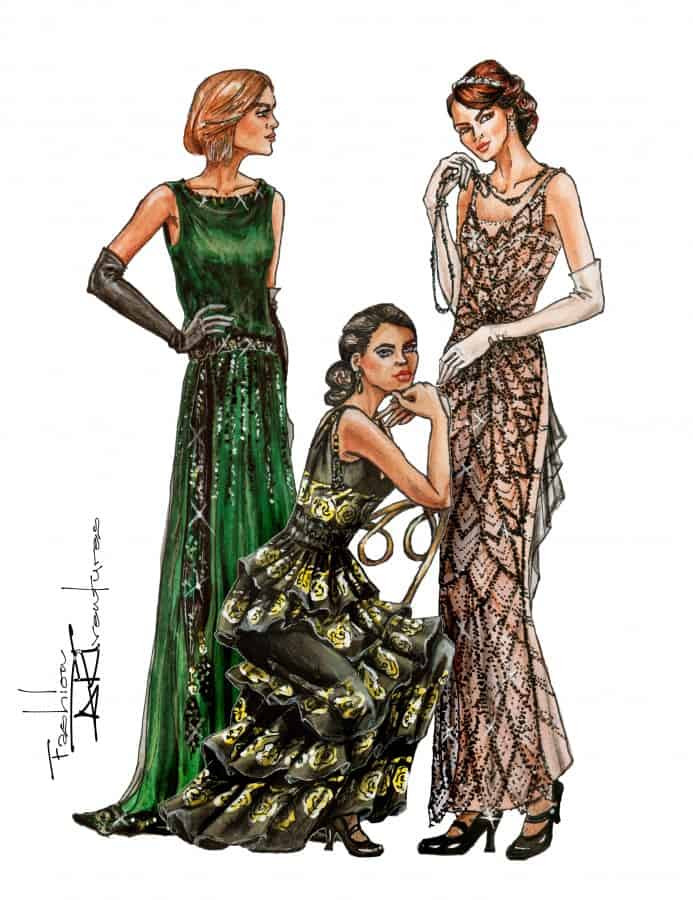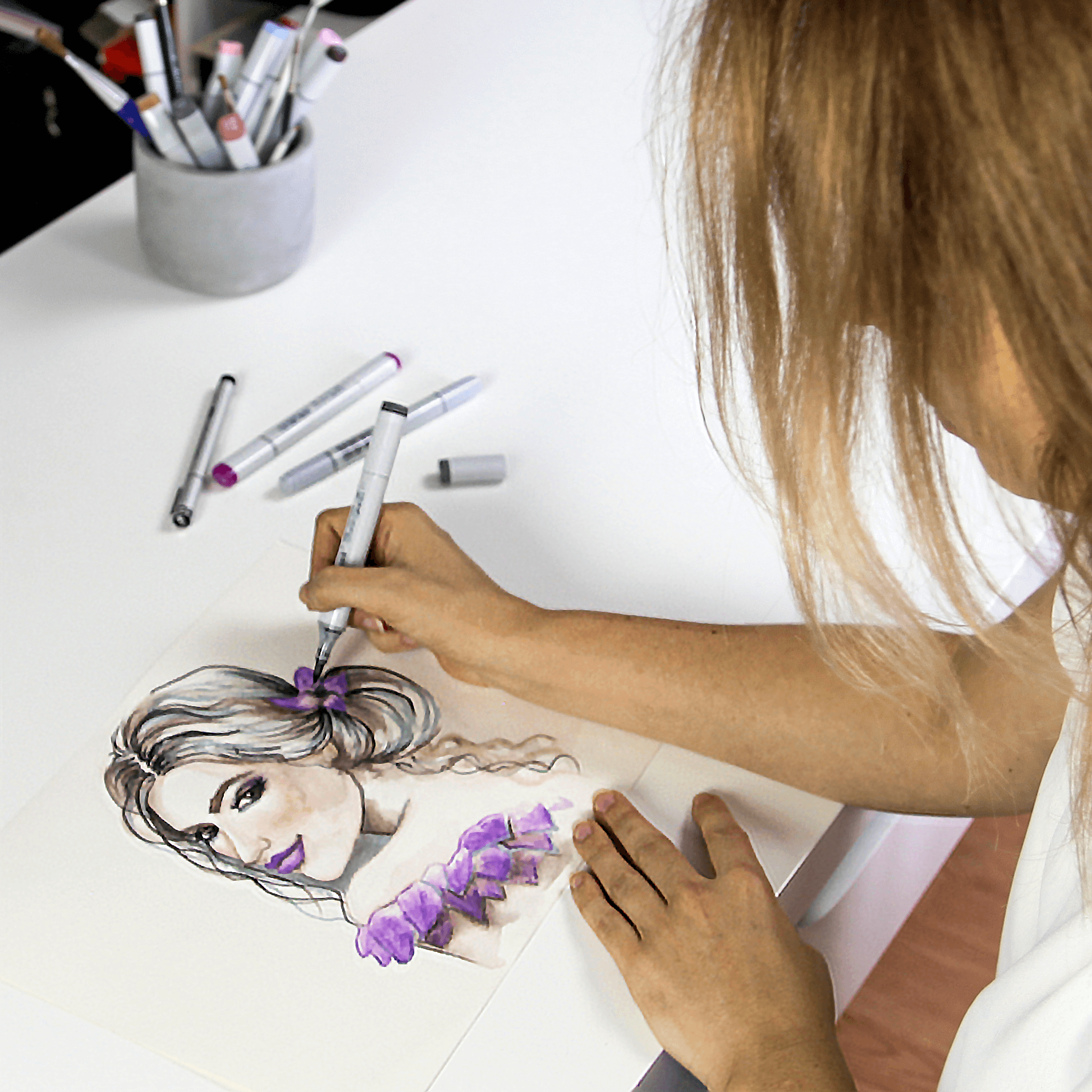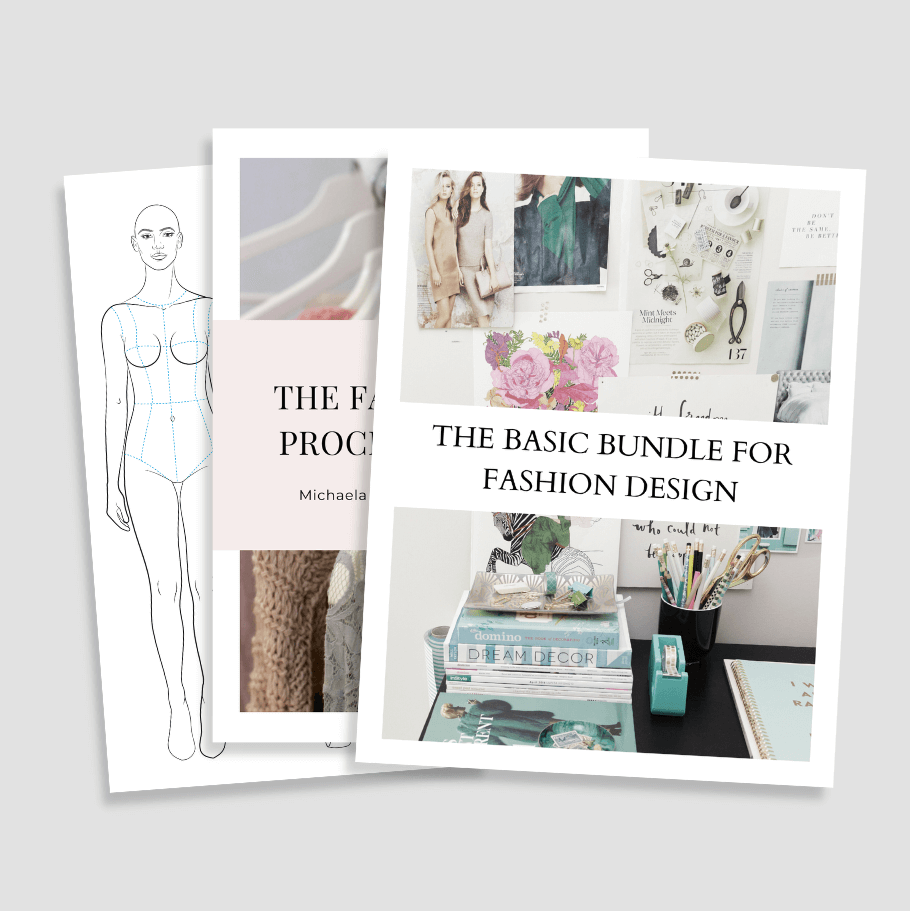Your Free Gift The Basic Bundle for Fashion Designers
Your Free Gift The Basic Bundle for Fashion Designers

Edith Crawley played by Laura Carmichael is the second daughter to Lord and Lady Grantham. Her dresses reflect her personality with their simplicity and rather unimpressive designs.
This is a simple pose perfect for a dress. The hand resting on the hips gives it an elegant touch. The figure is shown in the 3/4 view.
The torso’s movement is very slightly concave making a C-shape. To make the figure look more graceful or fragile, indicate the collar bones and the pit of the neck. Don’t forget that the body is not flat. The garments are wrapping around the body parts.
For the skin tone, I used transparent drawing ink in Burnt Sienna. Let it dry and then render the shadows with pencils or by layering the ink. When you draw the hair, start with the light shade for the highlights and then go on with the darker tone.
Edith Crawley played by Laura Carmichael is often the “forgotten” one as she was not as pretty and smooth-talking as her older sister Mary and less daring and passionate than Sybil, the youngest.

For this tutorial, I changed one of her dresses and made it more glamorous by adding a belt/facing at the lower waist finished at each end with a beaded tassel. The tassel is constructed of black beads. The dress is made of emerald green silk covered with a layer of black chiffon with elegant embellishment at the waist and at the very bottom made of black beads and sequins. There are also several rows of sequins and beads scattered down the hips. I filled in the dress in emerald green and then used black shade to render the shadows. Use a black marker, fine liner, or ink for the sequins. A soft yellow soft pastel renders the reflections of the fabric at the convex areas of the body. Use a white gel pen, opaque white paint or white ink to add reflections in the sequinned areas.
The figure is in a rather unspectacular pose but you can make it interesting by changing the motions of her arms. If you want to see how to draw this simple 3/4 front view, watch it here.
[line]
To show you the difference between a standing and a sitting figure I used two scales. The one is 9 head-unit tall, the second is a 6 1/4 unit-scale.
A sitting person is about 6 1/4 heads tall. With the middle point or crotch at the 2 1/4 heads-unit-line. A chair is approximately 2 head-units high slightly beneath the knees.
The figure is leaning forward on the back of the chair with her head resting on her hands. Block in the torso and the pelvis by using geometric shapes. This will make your work easier when you start to illustrate the body. There is a foreshortening effect on the legs caused by their angle to the viewer. The arms and the hands need a bit more attention this time, but with a bit of patience and practice you’ll master it. Make a rough sketch of the dress. Pay attention to the direction of the ruffles. They should follow the shape of the body and change their direction when wrapping around it. Try to make the position of the knee visible although it’s covered by the dress.
Lady Sybil Crawley played by Jessica Brown Findlay is the youngest daughter to Lord and Lady Grantham. She is the family rebel. Her gowns have often asymmetrical cuts. They always have details like flower prints, embroideries, or ruffles emphasizing Sybil’s sweetness. The dress is made of multiple ruffled layers of black silk with a print of golden roses.
Before I rendered the black silk, I masked the flower print of the dress with masking fluid. Masking fluid or frisket is a removable, colorless liquid to mask areas of work that need protection when color is applied in broad washes. The masking fluid can dry transparently like mine or in light blue color. To remove it from the paper just rub it off with your finger or use an eraser. I used transparent ink in burnt sienna for the skin color and added shadows with colored pencils in different brown shades.

When you render the highlights and shadows, don’t bother about going over the roses with the brush. The masking fluid will prevent the black color to cover the flower print. If you have to use a marker or some kind of pencils and pastels, be careful with the masked areas because the ingredients in the marker or the hardness of the pencil might rub them off. I used a pale yellow soft pastel to add some highlights. Once all colors are dry, use your finger to rub the mask off…
For the flower print, I used three colors- pale yellow for the highlights, lemon yellow for the mid-tones, and white for the light reflections, because it’s a print of golden roses. In the darkest areas of the ruffles, I added some black pencils to render the shadows. A black fine liner was great to draw in the petals of the roses. Add a few reflections with a milky gel pen…
If you want to see how to draw this sitting fashion figure, watch it here:
The figure is in a rather unspectacular pose but you can make it interesting by changing the motions of her arms.
Pre-sketch the body parts. The torso is in an opposite angle to the angle of the pelvis and the knees. The dress is from the 1920s and therefore straight cut. I shouldn’t hint at any waist or bust in the design, but I wanted a little bit of feminine shape in the dress. The arms are giving the figure an elegant and graceful touch. In her right hand, she will later hold a long necklace. The dress has a complex star-like or flowery pattern made of black and silver beads and crystals sewn to a layer of black chiffon. There is also a short trail-like element at the back of the dress beginning at the waist and ending in the area of the lower legs.
Lady Mary Crawley played by Michelle Dockery is the eldest daughter to Lord and Lady Grantham. All of her gowns are very playful in design and only the best of fashion. Her dresses are the most elaborate designs in the show. She wears a lot of lace and embroideries with details like beads, sequins, and multiple layers of different fabrics giving the dress a completely new shape or appearance.
I used an ivory shade for the gloves and a dark brown for the shadows in the fabric. For the shadows in the face, the perfect choice was some cinnamon brown and burnt umber. The dress shown in this drawing is a neutral-colored gown covered with black chiffon. The front is highly elaborate with black and silver beads and crystals creating a flowery or star-like pattern. The dress is in a tan color but with a slightly peachy shade. So I mixed burnt sienna, the color that I used for her skin, with a tiny bit of crimson red and came out with this new shade for her gown.
While the color was still wet I added some deep purple to indicate few shadows in the fabric. For the short trail-like element at the back of the dress, I used a black coal pencil and blended it out with a tortillon to get a transparent appearance. Take a marker, a fine liner, or a black pencil and start drawing the flower pattern. The petals’ contours are made of double-row beads. I used a thicker marker for these. The pattern is creating radial spreads with the central point in the area of her waist. Going further down the petals are changing their size. They become larger. With a thinner fine liner draw in the single- row- beads in the inner part of each petal. I know it’s a lot of work…
Take white paint or ink and a thin brush and make some light reflections in the pattern. There are also silvery sequins along the neckline and a row of crystals at the bust.
The figure is in a rather unspectacular pose but you can make it interesting by changing the motions of her arms. If you want to see how to draw this simple and youthful elegant fashion figure, watch it here:
if you liked this post, you'll PROBABLY be into these—
Business tools, art materials, equipment
You wanna see my secret weapons for running my biz and creating art? Here is a sneak peek at what’s happening behind-the- scenes at Fashion ARTventures.
This is everything I have used and loved, from my art techniques and software, to my filming equipment and platforms that help me run my biz !


THE BASIC BUNDLE is a collection of female fashion templates in the most essential poses + the fashion design process checklist and the fashion figure proportion scale for sketching the croquis freehand.
Grab your favorite paints or your iPad, put on some chill tunes, find a cozy spot, and let us take you on a journey full of ARTventures! As you color, you’ll be practicing your artistic skills, exploring color combinations, and improving your eye for design.
We noticed you're visiting from Latvia. We've updated our prices to Euro for your shopping convenience. Use United States (US) dollar instead. Dismiss